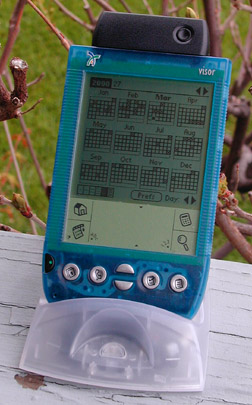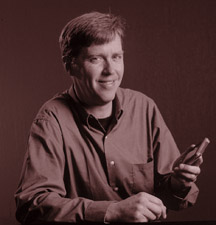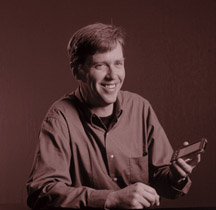Jeff Hawkins
The man who almost single-handedly revived
the handheld computer industry
Part 3
The secret of his success
For those of us who are happy owners of Palm computers, the reason for this success seems obvious, but there are hundreds of competing businesses and mobile technology watchers who want to know why the Palm is successful.

"I think a lot of the success of the original Pilot," says Hawkins, "was because of the fact that we really thought through this usage model of being better than paper." The Palm is about as small as a simple pad of Post-its, but it can do a whole lot more in the same space. Programs run one at a time, but you can switch between the basic applications with the push of a button, certainly a lot faster than thumbing through a pad or binder of paper.
"What we've seen so far, both at Palm and Handspring," says Hawkins, "is that the appeal of a handheld computer is very broad. It's broad in its demography and it's broad in its geography; that is, today we don't sell many to senior citizens, but when they get one, they really like it, and they find it valuable. If you give one to a five-year-old or a ten-year-old, they like it. They may do something totally different with it, they may play games on it, but there really is an attraction to the product. And we've seen the same attraction all around the world. So I see it as inevitable that a reasonably large portion of the world population will own one of these things. And, you know, how big, what year, I don't know.
"It's like cellular telephones, how they're spreading into third world communities, where people don't have any infrastructure, they don't have reliable power, they don't have a telephone system, but they've got cell phones! And the same sort of demographic appeal and shift is going to happen in handheld computers. There seems to be almost no limit to who can benefit from the products. We think it's just a huge business opportunity.
"That's why we view the handheld computer being--I like to say the successor to the PC, but I don't mean that it replaces the PC. It sort of picks up the baton and goes the next step further. PC's will always be there, they'll always stick around, they'll always do what they do. You'll need it, but the number of people who can use a Visor is larger than the number of people who--around the world--can use a PC. It's more affordable, more supportable, it can be powered with batteries that are available everywhere."
Supporting Jeff's vision of simpler computers--designed from the start to be better than paper, rather than mini-desktops--is the relative failure of Windows CE-based computers in the marketplace. Looking at the lessons Hawkins himself learned with the Zoomer, it's no wonder that a platform based on an OS made by one company and hardware made by a number of companies hasn't succeeded, even when the hardware itself uses more powerful processors, snappier graphics, sound, higher-resolution screens, color screens, and even MPEG video.
"My entire life has been a continuous stream of threats from the Microsoft juggernaut," said Hawkins. "When I was back at GRiD, there was Windows for Pen Computing, and then there was WinPad, and Windows at Work, then Windows CE 1.0, Windows CE 2.0. You can spend your whole life and career watching what Microsoft does, instead I prefer to go build some products; and if they have something great to use, then maybe I'll use it. But we had to decide--instead of reacting to Microsoft, let's go build just fantastic products. We did the Palm V, we did the Palm VII. We're not going to do what they're doing, we're going to do what we think is the right thing to do and believe that--sort of the American way--if you do the right thing you'll win."
Palm departure

November 1998 saw the departure from Palm of Hawkins, Dubinsky, and Ed Colligan, their long-time Marketing man. The departure shook Silicon Valley and set wild speculation loose in the press. For their part, Hawkins, Dubinsky, and Colligan were upbeat, saying that they were looking forward to enjoying the agility inherent in running a small company again. They started their own company, unsure of what kind of small computer they would make, but they'd licensed the Palm OS, and knew they could come up with something.
It wasn't until nearly a year later that we found out more details about the departure. Shortly after their deal with US Robotics, the deal that gave them the funding to produce the Pilot in the first place, modem-maker USR was bought by networking giant 3Com. In retrospect, it was actually a faulty move on 3Com's part, considering that today they're spinning out and selling off nearly all that they bought three years ago. Regardless, 3Com had initially balked at their inadvertent purchase of Palm, because it didn't seem to fit into their other businesses. Business analysts as well said it made them unattractive to suitors and stockholders. So when Hawkins and Dubinsky went to Eric Benhamou, 3Com's CEO, asking him to spin Palm off, they were surprised when he said Palm would never be spun off, it was too important to their business.
So they left to form Handspring. And a week before they were to launch their new product, they went in to show it to Benhamou as a courtesy. It was then that he shared he would have an announcement of his own, one that would come just a day before their new product announcement: 3Com would spin Palm off.
Hawkins told the San Jose Mercury News on the day after Palm's announcement, Visor's announcement date, "If they had spun us out, I'd still be there."
The new company

Now at Handspring, Hawkins is continuing to try to do the right thing that will help the company win. Where before he eschewed piling on loads of features, he's added the Springboard slot to his small computer, allowing it to be easily customized by the user. It's still simple, and still in the Palm form factor, but now it has an expansion slot. Many customers who know of the Hawkins/Dubinsky/Colligan team, and love their Palms, have bought Handspring's new offering, the Visor, seeking to follow the people who created the computer they have found indispensable.
They launched the Visor on September 14, 1999, and were instantly overwhelmed with orders for the product, which created a four to six week backorder. It wasn't until January 2000 that they were getting orders out in less than a week. Now, with the shipping of their modem module, and amid announcements of exciting products like camera modules and radio modules, Handspring is on its way to the success that Hawkins will need to resume his work in neurobiology.
"At the end of my time at Palm," said Hawkins, "I was working part time because I was writing a book on this stuff [brain research and theory]. And I realized that part time it was going to take forever to write this book! Unfortunately what happened was that we decided they weren't going to spin Palm out of 3Com. We had worked hard on getting them to spin Palm out, they said they would not do it; impossible. So I committed to Donna and Ed Colligan that, 'Hey, we'll start another business, I'll work full time on it, and we'll make that a success. And after that I'll get back into my brain stuff.'
"My focus today, 100 percent, is making Handspring successful, making handheld computing successful. I still view the handheld computing industry as very embryonic, it's very early on. It's like 1982 of the PC world. And the big things haven't happened yet. As much success as Palm has had, and as much success as Handspring is currently having, it's just the beginning and it takes a lot of concentrated effort to build a big business. And we think Handspring's going to be a very big business."
Those who've worked with Hawkins all agree that he's a man destined for success, while remaining a very approachable and likeable guy.
"He was the reason I came to Handspring," said Greg Shirai, a Handspring Product Manager.
When asked why their partnership works so well, Dubinsky said, "Our partnership works because we really respect and like each other. I don't see how two people could work so closely together who didn't enjoy each other!"
"Working with Jeff," says Walker, "I was always aware of a 'creative force' and an intelligence that was way beyond average. He clearly had an ability to look at a wide range of product and technical possibilities that could exist in the future, focus in on the one that seemed to make the most sense, and then start creating core and related elements that would help make the chosen possibility happen. He was, and still is, very unassuming. So if you couple the 'regular guy' feeling that he projects with the creative force and intelligence, you get someone who has a very strong influence on everyone around him. The 'regular guy' persona makes his influence even stronger than it would be if he had an 'executive' or 'genius' persona."
"Jeff is a great visionary and a genuine nice guy," says Ken Dulaney. "Don't find that very often. I really am pleased that I had the pleasure of working with him for so many years. We remain good friends."
As for Jeff's assessment: "I kinda like to think I'm just like anybody else, and I'm trying to build products that are for anybody else. I always want to put an edge in them so they're attractive to people who are technically elite and smart--I try to make them exciting--but I'm also trying to balance both worlds. How do you make an exciting product that's pushing the envelope in some ways, but on the other hand is usable and accessible to a very broad populace?"
Jeff Hawkins is clearly the one man able to answer that question.
-Shawn Barnett
Personal Statistics
Name: Jeff Hawkins
Born: June 1, 1957
Where: Long Island, Huntington, New York
Interests: Sailing, time with family, playing musical instruments
Family: Wife and two daughters
Education: Cornell University, BSEE; UC Berkeley, BioPhysics study
Title at time of story: Chairman and Chief Product Officer, Handspring, Inc.
First computer used: "A time-sharing computer with a paper-tape based teletype terminal; first one I used at work was an Intel Model 800 development system with two 3MB disk drives. And the first I owned at home was a Mac 512K."
To see the MIT story mentioned in Part 1, follow this link: http://www.technologyreview.com/magazine/jul99/qa.asp
|









